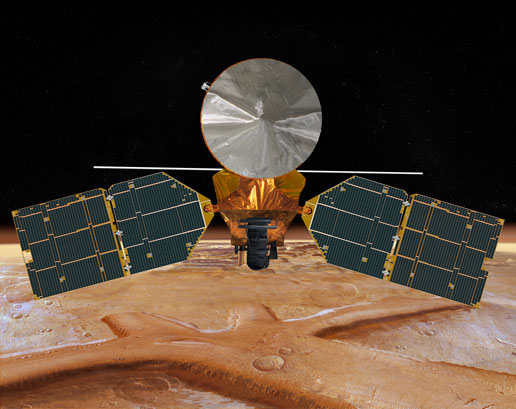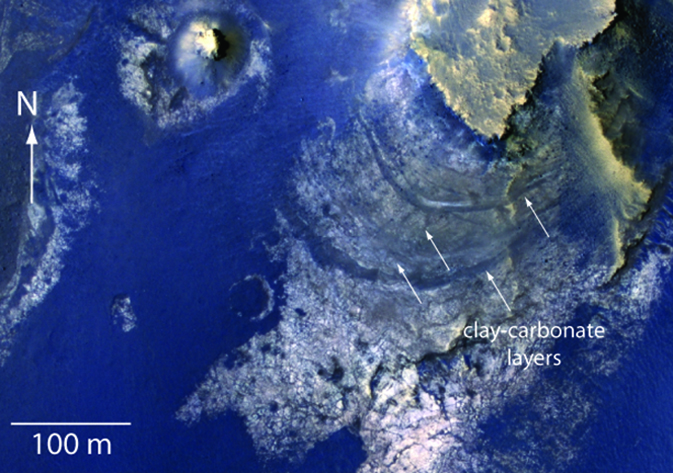NASA’s orbiter finds evidence of groundwater-fed lake on Martian crater McLaughlin

Observations of spectrometer data from NASA’s Mars Reconnaissance Orbiter (MRO) provide new evidence of a wet underground on Mars, NASA reported on January 20, 2013. Crater McLaughlin, the one under observation, is 57 miles (92 kilometers) in diameter and 1.4 miles (2.2 kilometers) deep. Scientists believe underground water could have flown into the crater’s interior because of its depth, instead of staying hidden. Layered, flat rocks at the bottom of the crater contain carbonate and clay minerals that require presence of water for formation.
Further, no large inflow channels were found, whereas small channels that originate within the crater wall, end near a level that could have marked the surface of a lake. These findings suggest that once there existed a groundwater-fed lake within crater’s closed basin, where carbonates and clay formed. Some researchers propose the crater interior catching the water and the underground zone contributing the water could have been wet environments and potential habitats.
 This view of layered rocks on the floor of McLaughlin Crater shows sedimentary rocks that contain spectroscopic evidence for minerals formed through interaction with water. Note – It is a color enhanced image, what’s visible is not water. Image credit: NASA/JPL-Caltech/Univ. of Arizona
This view of layered rocks on the floor of McLaughlin Crater shows sedimentary rocks that contain spectroscopic evidence for minerals formed through interaction with water. Note – It is a color enhanced image, what’s visible is not water. Image credit: NASA/JPL-Caltech/Univ. of Arizona “Taken together, the observations in McLaughlin Crater provide the best evidence for carbonate forming within a lake environment instead of being washed into a crater from outside,” said Joseph Michalski, lead author of the paper, which has five co-authors. Compact Reconnaissance Imaging Spectrometer for Mars (CRISM) on MRO was used to check for minerals such as carbonates, which are best preserved under non-acidic conditions. CRISM Principal Investigator Scott Murchie of the Johns Hopkins University Applied Physics Laboratory in Laurel, Md. said,
“The MRO team has made a concerted effort to get highly processed data products out to members of the science community like Dr. Michalski for analysis. New results like this show why that effort is so important.”
McLaughlin Crater sits at the low-end of a regional slope several hundreds of miles, or kilometers, long on the western side of the Arabia Terra region of Mars. As on Earth, groundwater-fed lakes are expected to occur at low regional elevations. Therefore, this site would be a good candidate for such a process. Michalski further says,
“A number of studies using CRISM data have shown rocks exhumed from the subsurface by meteor impact were altered early in Martian history, most likely by hydrothermal fluids. These fluids trapped in the subsurface could have periodically breached the surface in deep basins such as McLaughlin Crater, possibly carrying clues to subsurface habitability.”
MRO has been orbiting and photographing the Red Planet since 2006. Equipped with six instruments, it has provided more high-resolution data than all other Mars orbiters combined.
The findings are published online edition of Nature Geoscience.
Source: JPL/NASA
Featured image: NASA/JPL – This artist’s concept of the Mars Reconnaissance Orbiter features the spacecraft’s main bus facing down, toward the red planet. The large silver circular feature above the spacecraft bus is the high-gain antenna, the spacecraft’s main means of communicating with both Earth and other spacecraft.

Commenting rules and guidelines
We value the thoughts and opinions of our readers and welcome healthy discussions on our website. In order to maintain a respectful and positive community, we ask that all commenters follow these rules:
We reserve the right to remove any comments that violate these rules. By commenting on our website, you agree to abide by these guidelines. Thank you for helping to create a positive and welcoming environment for all.